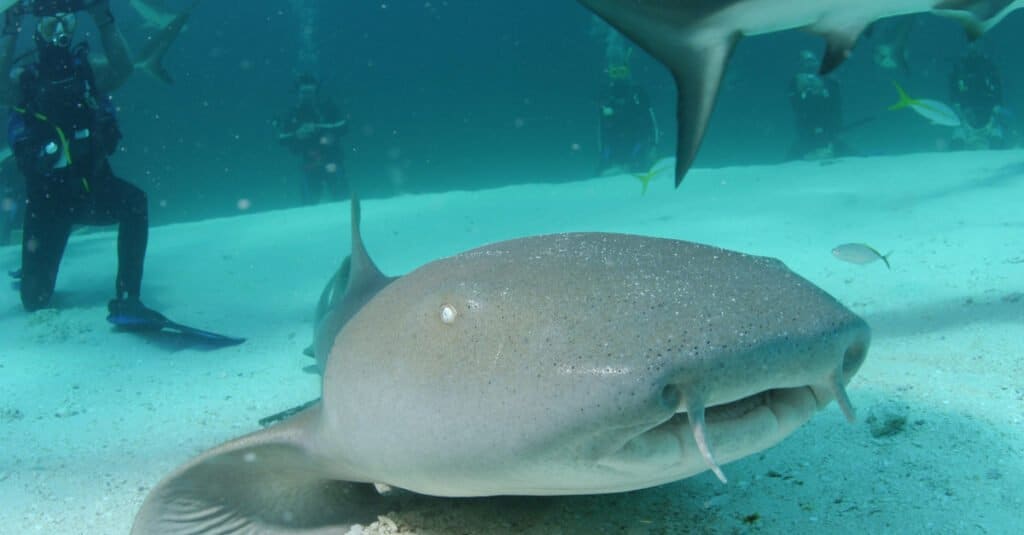Nurse sharks have a slightly rounded appearance, which sets them apart from other shark species. It is quite common to find them dwelling together in a group with other nurse sharks. They are bottom-dwelling fish that blend in their surroundings quite easily. Nurse sharks are solitary hunters, and will always return to any comfortable spot they choose as their home.
Since they have the habit of returning to the same spot, they are relatively easy to find if you know where to look. In this article, we will examine the living habits and locations of nurse sharks across the world.
Where Do Nurse Sharks Live?

Adult nurse sharks or sleeper sharks, as they are commonly called, stay in waters around the intertidal zone.
©frantisekhojdysz/Shutterstock.com
Nurse sharks are local to Central American waters. They can be found in tropical waters or warm shallow waters on the continental shelves, the Eastern Pacific Ocean, and the Western Atlantic Ocean.
Adult nurse sharks or sleeper sharks, as they are commonly called, stay in waters around the intertidal zone. They have a distinctive flat head, with small eyes, two barbels (used for tasting), and round bodies. You can find them in Atlantic Ocean’s waters from Rhode Island to Southern Brazil and Cameroon down to Gabon. They also live in the Caribbean Islands. In general, they love reefs, sand flats, and mangrove Islands.
Nurse sharks also thrive in captivity, so, aquariums around the world keep and raise them. The South Carolina Aquarium in South Carolina and the Greater Cleveland Aquarium in Cleveland are some popular examples. Some other nurse shark hotspots are Compress Cay in the Bahamas, beaches in Miami, Belize, Isla Mujeres in Mexico, and the Gulf and Atlantic Coasts of Florida. They can also be found in Egypt, Australia, and South Africa.
How Do Nurse Sharks Live?

Nurse sharks are very laid-back creatures.
©tali de pablos/Shutterstock.com
This species of shark is very laid back. This behavior along with their rounded physique has earned them the title “couch potatoes of the sea”. One incredible fact about nurse sharks is that they spend most of the day lying at the bottom of the ocean. Their biology also encourages their lazy living.
Nurse sharks breathe through a method called buccal pumping. Unlike great whites who need to swim constantly in order to respire, sleeper sharks simply suck in oxygen by flexing their oral muscles. They also have two barbells which help them detect food, particularly squids, small stingrays, and crabs buried in the sand. Most nurse sharks spend their lifetime lounging in a pile with other fellows, or out in search of food. This has earned them a spot on the list of the laziest animals in the world.
As bottom dwellers, nurse sharks tend to hunt within 65 to 250 feet of the ocean’s floor. The juveniles reside primarily in caves, shallow reefs, and seagrass beds, although, schools are spotted near the seashores quite frequently for fish hunting.
How Far Down Do Nurse Sharks Live In?

Typically, nurse or sleeper sharks stay within 3.2 to 40 feet of water, resting and cuddling other sleepers. They are, however, solitary hunters who can go as deep as 246 feet in travel. Nurses tend to stick to reefs and flats where there is an abundance of food. So, a school will likely make its home in a warm coral or rocky reef and swim out at night to hunt. They eat sea urchins, shrimp, crustaceans, and other small fish they are able to draw into their mouths.
The nurse shark’s typical swim range is quite small unlike their counterparts: the Grey Nurse shark. Now, these are two different shark species even though they have the same names. Grey nurse sharks are also bottom-dwelling sharks, but they differ in appearance from sleeper sharks. They are also highly migratory. This species of shark is known to travel up to 1900 miles of deep waters annually. This migratory nature is one of the major differences between nurse sharks and grey nurse sharks.
In recent times, however, sleeper sharks have been found migrating from the Western Coast of Florida down to Tampa Bay.
Do Nurse Sharks Come Close to Shore?
Yes, they nurse sharks come close to shore. Nurse sharks love shallow waters and often come close to areas with human activity. This is usually at dusk or dawn since those are the times when they are most active. They live in intertidal zones, which bring them pretty close to the shore.
Sharks, in general, can swim as close as a hundred feet to shore if there is a gathering of plenty fish. Likewise, nurse sharks swim up to shore while trailing stingrays, fish, crabs, and other crustaceans. Hammerheads and lemon sharks also swim close to shore, especially on the coast of Florida. There have also been many sightings of nurse sharks swimming along shores and beaches in Florida, just as there have been instances of shark attacks at sea.
Will a Nurse Shark Bite You?
Although nurse sharks are not aggressive towards humans, they may bite when provoked. These sharks are docile in nature and will normally refrain from attacking divers. However, the fact remains that they are wild animals, and can sometimes be unpredictable.
Over the years, there have been news reports about people who had small nurse sharks clamp down on their arms or feet. A nurse shark’s jaw is filled with many sharp teeth which will definitely leave bite marks and probably cause injuries. So far, however, there haven’t been any fatalities.
The photo featured at the top of this post is © Maui Topical Images/Shutterstock.com
Thank you for reading! Have some feedback for us? Contact the AZ Animals editorial team.






